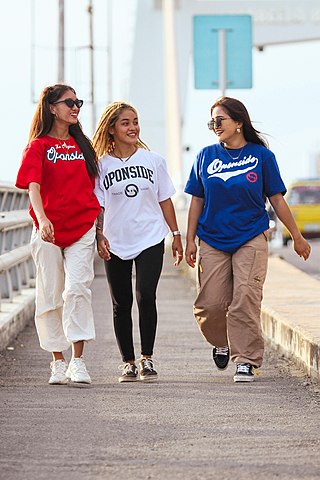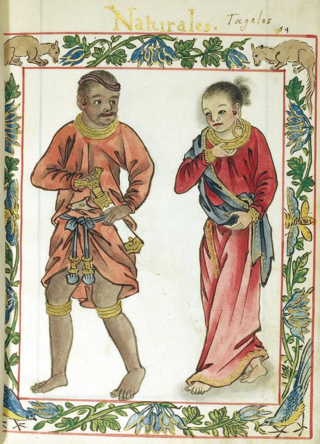
Tondo is a district located in Manila, Philippines. It is the largest, in terms of area and population, of Manila's sixteen districts, with a census-estimated 654,220 people in 2020. It consists of two congressional districts. It is also the second most densely populated district in the city.

The Laguna Copperplate Inscription is an official acquittance certificate inscribed onto a copper plate in the Shaka year 822. It is the earliest-known, extant, calendar-dated document found within the Philippines.
Lakandula was the title of the last lakan or paramount ruler of pre-colonial Tondo when the Spaniards first conquered the lands of the Pasig River delta in the Philippines in the 1570s.

Women in the Philippines may also be known as Filipinas or Filipino women. Their role includes the context of Filipino culture, standards, and mindsets. The Philippines is described to be a nation of strong women, who directly and indirectly run the family unit, businesses, and government agencies.

In early Philippine history, the Tagalog and Kapampangan settlement at Tondo, sometimes referred to as the Kingdom of Tondo, was a major trade hub located on the northern part of the Pasig River delta on Luzon island. Together with Maynila, the polity (bayan) that was also situated on the southern part of the Pasig River delta, Tondo had established a shared monopoly on the trade of Chinese goods throughout the rest of the Philippine archipelago, making it an established force in trade throughout Southeast Asia and East Asia.

Namayan, also called Sapa, Maysapan, and sometimes Lamayan, was an independent indigenous polity on the banks of the Pasig River in the Philippines. It is believed to have achieved its peak in 1175, and to have gone into decline sometime in the 13th century, although it continued to be inhabited until the arrival of European colonizers in the 1570s.

In Philippine history, the Tagalog bayan of Maynila was one of the most cosmopolitan of the early historic settlements on the Philippine archipelago. Fortified with a wooden palisade which was appropriate for the predominant battle tactics of its time, it lay on the southern part of the Pasig River delta, where the district of Intramuros in Manila currently stands, and across the river from the separately-led Tondo polity.

The recorded history of the Philippines between 900 and 1565 begins with the creation of the Laguna Copperplate Inscription in 900 and ends with the beginning of Spanish colonization in 1565. The inscription records its date of creation in 822 Saka. The discovery of this document marks the end of the prehistory of the Philippines at 900 AD. During this historical time period, the Philippine archipelago was home to numerous kingdoms and sultanates and was a part of the Indosphere and Sinosphere.

The earliest recorded history of Manila, the capital of the Philippines, dates back to the year 900 AD, as recorded in the Laguna Copperplate Inscription. By the thirteenth century, the city consisted of a fortified settlement and trading quarter near the mouth of the Pasig River, the river that bisects the city into the north and south.
In Philippine folk tradition, Rajah Salalila was the Rajah or paramount ruler of the early Indianized Philippine settlement of Maynila, and the father of the individual named Ache, who would eventually be well known as Rajah Matanda. Based on perceived similarities between the names, he is sometimes also called Sulaiman I in the belief that he shared the name of his supposed grandson, Rajah Sulayman.

Dayang Kalangitan is a legendary figure in early Philippine history who was said to be Dayang of the pre-Hispanic Indianized polity of Pasig. She was co-regent of Pasig with her husband, Rajah Lontok, and later sole ruler of their realms. She is one of the very few known female leaders in precolonial Philippine history.
Kalangitan is a Philippine Historical Fiction Novel written by A.F. Eleazar. The plot revolves around a princess named Dayang Kalangitan who became the Queen Regnant of Namayan, Teunduk, and Meneuk kingdom. As described on the novel, Kalangitan is the most powerful woman in the Maisung at the time of her reign. The novel tackled the history of pre-Hispanic Philippines and the tradition of monogamy, justice system, culture and social norms. The main gist of the novel is about feminism during the pre-colonial era as it shows on the way it was written. It also explore the genre of Philippine mythology, epic and legends. It also contains allegories and subliminal messages as seen on the succeeding chapters of the book. The story was set in Manila during 1450 A.D.

Jayadewa or Jayadeva was the name of the Lord Minister of Pailah at the time that the Laguna Copperplate Inscription was written in c. 900 CE. According to the document, he served as the representative of the "Commander in Chief" in pardoning the descendants of an individual named Namwaran of his debts. Although no other records describe his life and works, Jayadewa is an important figure in Philippine historiography because he is one of the persons clearly identified in the LCI, which is the earliest known written document found in the Philippines.
Old Tagalog, also known as Old Filipino, is the earliest form of the Tagalog language during the Classical period. It is the primary language of pre-colonial Tondo, Namayan and Maynila. The language originated from the Proto-Philippine language and evolved to Classical Tagalog, which was the basis for Modern Tagalog. Old Tagalog uses the Tagalog script or Baybayin, one of the scripts indigenous to the Philippines.
Malay spoken by a minority of Filipinos, particularly in the Palawan, Sulu Archipelago and parts of Mindanao, mostly in the form of trade and creole languages, such as Sabah Malay.

Malays played a significant role in pre-Hispanic Philippine history. Malay involvement in Philippine history goes back to the Classical Era with the establishment of Rajahnates as well as the Islamic era, in which various sultanates and Islamic states were formed in Mindanao, the Sulu Archipelago, and around Manila.
In the Philippine languages, a system of titles and honorifics was used extensively during the pre-colonial era, mostly by the Tagalogs and Visayans. These were borrowed from the Malay system of honorifics obtained from the Moro peoples of Mindanao, which in turn was based on the Indianized Sanskrit honorifics system and the Chinese's used in areas like Ma-i (Mindoro) and Pangasinan. The titles of historical figures such as Rajah Sulayman, Lakandula and Dayang Kalangitan evidence Indian influence. Malay titles are still used by the royal houses of Sulu, Maguindanao, Maranao and Iranun on the southern Philippine island of Mindanao. However, these are retained on a traditional basis as the 1987 Constitution explicitly reaffirms the abolition of royal and noble titles in the republic.
The Bruneian–Tundun War, also called the Bruneian Expedition to Luzon and the Bruneian invasion of Tondo, was a military invasion and later occupation of Tondo in Luzon by the Bruneian Sultanate in the 15th century. The invasion resulted in the formation of the Kingdom of Selurong, the Brunei Sultanate chose to end the Dynasty of Tondo's monopoly in the China trade.






















